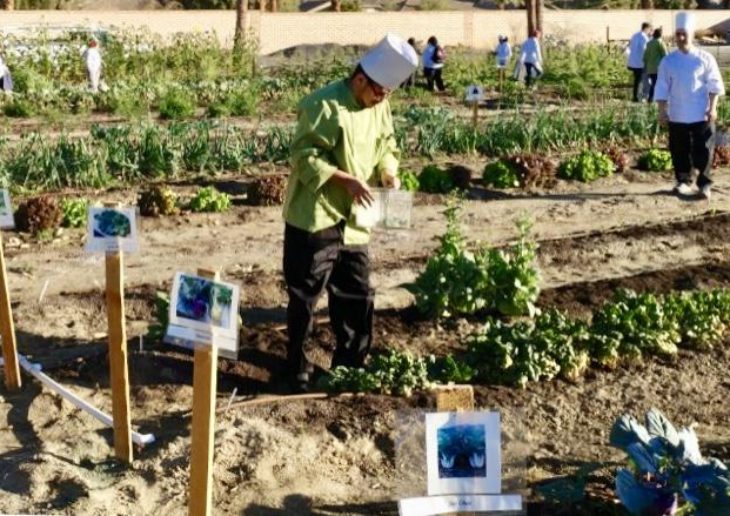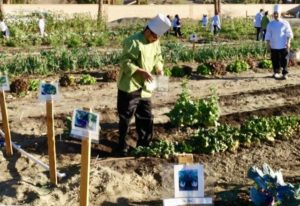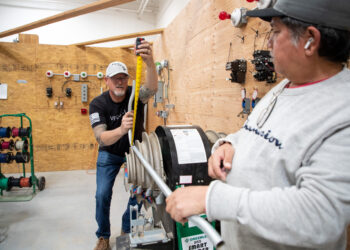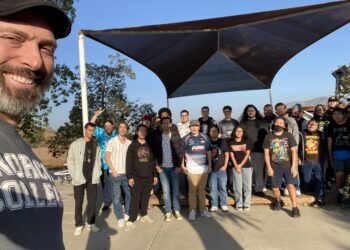Strong Workforce Program Pays Off at College of the Desert as California Students Land Jobs

Palm Desert, California – March 2018. Spotting a koi pond and a manicured golf green on a community college campus in California might signal luxury. But at the College of the Desert in Palm Desert, these are just the tools of the trade.
Millions of dollars in new state funding delivered through community colleges is successfully strengthening job prospects for students in California, from air conditioning repair and welding to culinary skills and landscape design. These hands-on career and technical classes are designed — and funded — to be direct paths to jobs with local industry.
 Strong Workforce money — $200 million annually approved by the California legislature in 2016 — has had one year of planning and one year of implementation. But already it is paying off in new equipment, new certificate programs and most importantly, new jobs. The goal is to create one million more middle-skill workers through career and technical education in California’s 114 community colleges.
Strong Workforce money — $200 million annually approved by the California legislature in 2016 — has had one year of planning and one year of implementation. But already it is paying off in new equipment, new certificate programs and most importantly, new jobs. The goal is to create one million more middle-skill workers through career and technical education in California’s 114 community colleges.
At the College of the Desert, the automotive shop sports the latest hybrid vehicles in the bay — the perfect laboratories to deliver skilled workers into the economy. Those cars helped Christina Schneider turn her life around. The 32-year-old grew up in Palm Springs, spent some time in jail for burglary. When she got out, she asked herself what she really wanted to do with her life. She decided it was car repair.
 “I like working with my hands and fixing things,” she said. “I like to take something that is broken and fix it and watch it work again.” Not only did College of the Desert admit her as a student, her instructors trusted her to check out the tools and laptops to other students. When she applied for a job as a mechanic at Hyundai in La Quinta, she was honest about the time in jail. They still hired her. “I’m proud of myself,” she said. “My life has never been better than it is right now.”
“I like working with my hands and fixing things,” she said. “I like to take something that is broken and fix it and watch it work again.” Not only did College of the Desert admit her as a student, her instructors trusted her to check out the tools and laptops to other students. When she applied for a job as a mechanic at Hyundai in La Quinta, she was honest about the time in jail. They still hired her. “I’m proud of myself,” she said. “My life has never been better than it is right now.”
Strong Workforce money has allowed College of the Desert to expand some programs that lead to jobs said Zerryl Becker, dean of Career and Technical Education at College of the Desert. They have added instructors, updated equipment and changed curriculum to match the needs of hiring managers in the area. Becker works with two other deans, Leslie Young and Kelly Hall, as well as an advisory committee to decide how Strong Workforce money is spent on her campus.
The Indian Wells Tennis Garden has been so impressed with the changes that they have offered to hire COD students to staff restaurants for a three-week tennis tournament, which could lead to new jobs.
A community garden, farmed by students, now delivers fresh produce to the large culinary program as well as the Child Development Center. Students training to be agricultural inspectors will be able to work with the exact model of drone used by the state.
 “Strong Workforce money inspires new ideas and removes the small obstacles,” Becker said. The money is flexible enough to pay for meetings with nurses, restaurateurs, electricians and others in industry who advise on curriculum. It makes the instruction more practical and realistic for students. It also customizes the training for the area and overcomes typical bureaucratic lines between departments.
“Strong Workforce money inspires new ideas and removes the small obstacles,” Becker said. The money is flexible enough to pay for meetings with nurses, restaurateurs, electricians and others in industry who advise on curriculum. It makes the instruction more practical and realistic for students. It also customizes the training for the area and overcomes typical bureaucratic lines between departments.
That hands-on attitude suits 32-year-old Jennifer Gary, who had taken psychology classes at College of the Desert. But then she realized something important. “I don’t want to be a psychologist,” she said. She is now halfway through a two-year program in nursing at College of the Desert. She wants to be a labor and delivery nurse. She knows that because she has already worked inside local hospitals, including Eisenhower, JFK and Desert Regional.
“Beginning first semester we had clinical rotations at local hospitals, and we do get lots of opportunities to speak to other nurses,” she said. “It is encouraging to know that they have come through the same program and have been able to find jobs.”
She believes in the premise behind Strong Workforce: to work closely with the industries of the community and to plan programs that are practical, rather than theoretical.
“That is the best way to build a community that is diverse,” Gary said. “We don’t need everybody to be a lawyer or a doctor. We need people to fix the air conditioning and the cars.” She said the only way to be successful is to find out what you are naturally good at. She graduates in December, 2018 and is confident she will land a job quickly because there is a nursing shortage.
One of the chief strengths of Strong Workforce funding is that it requires collaboration with the leaders of local industry. In the Coachella Valley, jobs are plentiful for lifeguards, golf course landscape maintenance workers, spa managers and yoga instructors, especially those well versed in geriatric yoga. That mix is very specific to the resort and vacation industry of the Coachella Valley.
A College of the Desert instructor used Strong Workforce money to take a class in the motions especially helpful for the elderly. “The grant money is flexible, so if your own department does not have the money for training, you can get it through Strong Workforce,” Becker said.
After 26 years as a faculty member, Becker knows how a small obstacle can stop a project. She said the Strong Workforce money helps her work closely with the Coachella Valley Economic Partnership group to target the right industries for the area. For instance, air conditioning repair is a job that pays $15 to $18 to start, and there are always high employment prospects in the desert.
Ironically, Becker said, students are so focused on getting the job that they forget to come apply for the certificate of completion from the training program. An online dashboard helps community colleges compare their success school by school, and it helps the state legislature and the public see the results from their investment in community colleges.
“You do not have to pay $10,000 for a year of vocational training at a for-profit school, said Julie Pehkonen, the chair of the Inland Empire/Desert Regional Consortium of 12 community colleges in Riverside and San Bernardino counties working to coordinate the Strong Workforce program. “You can get it very inexpensively at your local community college.”
She said she is excited to see students change their lives dramatically when they find out how direct the path can be from training to work. “I like watching kids find out that they love the job, and they don’t need to take any more math and science to get it.”

———————
Strong Workforce Program: To develop more workforce opportunity and lift low-wage workers into living-wage jobs, California took a bold step in 2016 to create one million more middle-skill workers. At the recommendation of the California Community College Board of Governors, the Governor and Legislature approved the Strong Workforce Program, adding a new annual recurring investment of over $200 million to spur career technical education (CTE) in the nation’s largest workforce development system of 114 colleges. For more information about Strong Workforce, please visit: http://doingwhatmatters.cccco.edu/StrongWorkforce/Overview.aspx.


 Strong Workforce money — $200 million annually approved by the California legislature in 2016 — has had one year of planning and one year of implementation. But already it is paying off in new equipment, new certificate programs and most importantly, new jobs. The goal is to create one million more middle-skill workers through career and technical education in California’s 114 community colleges.
Strong Workforce money — $200 million annually approved by the California legislature in 2016 — has had one year of planning and one year of implementation. But already it is paying off in new equipment, new certificate programs and most importantly, new jobs. The goal is to create one million more middle-skill workers through career and technical education in California’s 114 community colleges. “I like working with my hands and fixing things,” she said. “I like to take something that is broken and fix it and watch it work again.” Not only did College of the Desert admit her as a student, her instructors trusted her to check out the tools and laptops to other students. When she applied for a job as a mechanic at Hyundai in La Quinta, she was honest about the time in jail. They still hired her. “I’m proud of myself,” she said. “My life has never been better than it is right now.”
“I like working with my hands and fixing things,” she said. “I like to take something that is broken and fix it and watch it work again.” Not only did College of the Desert admit her as a student, her instructors trusted her to check out the tools and laptops to other students. When she applied for a job as a mechanic at Hyundai in La Quinta, she was honest about the time in jail. They still hired her. “I’m proud of myself,” she said. “My life has never been better than it is right now.” “Strong Workforce money inspires new ideas and removes the small obstacles,” Becker said. The money is flexible enough to pay for meetings with nurses, restaurateurs, electricians and others in industry who advise on curriculum. It makes the instruction more practical and realistic for students. It also customizes the training for the area and overcomes typical bureaucratic lines between departments.
“Strong Workforce money inspires new ideas and removes the small obstacles,” Becker said. The money is flexible enough to pay for meetings with nurses, restaurateurs, electricians and others in industry who advise on curriculum. It makes the instruction more practical and realistic for students. It also customizes the training for the area and overcomes typical bureaucratic lines between departments.

